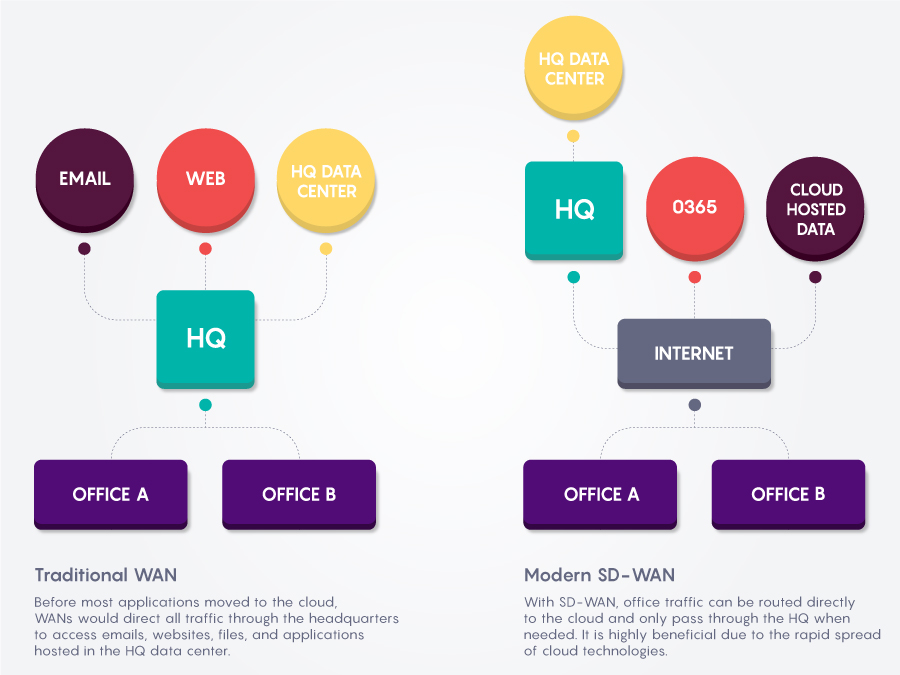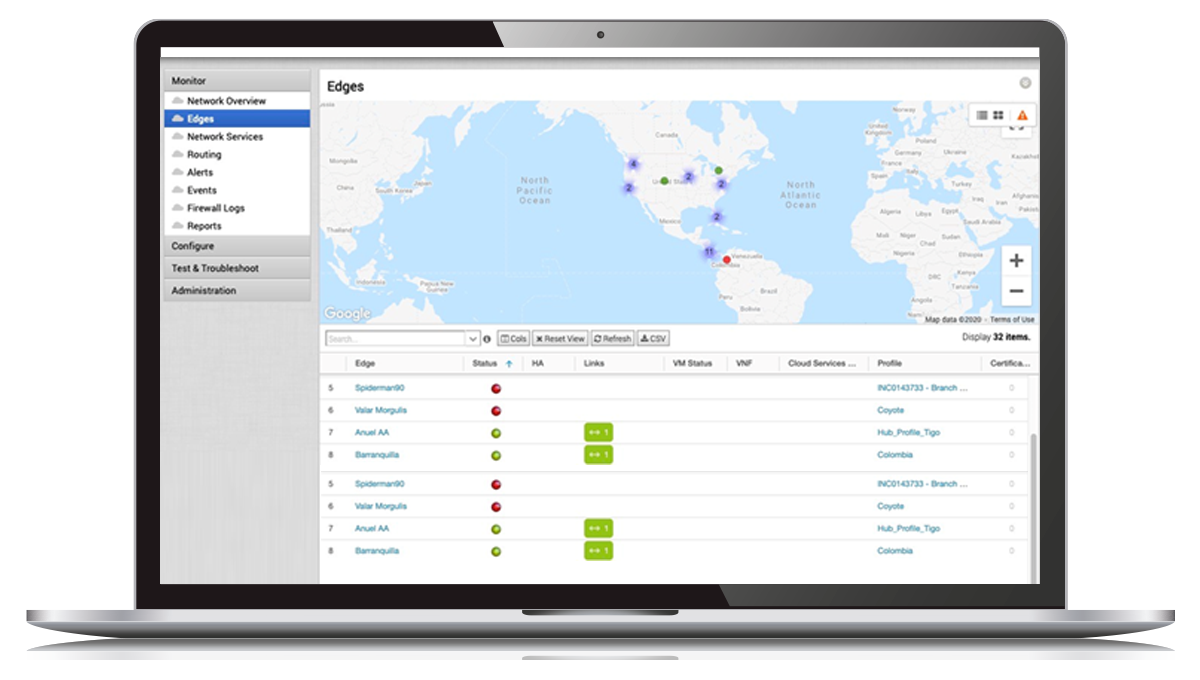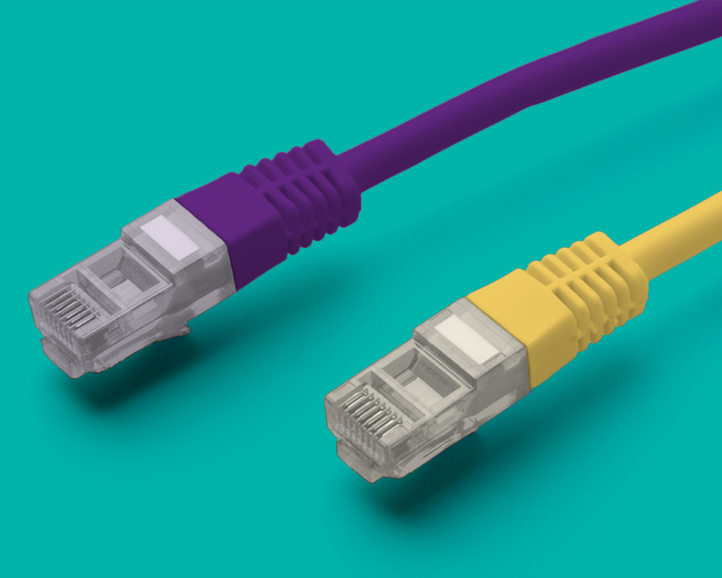SD-WAN Benefits: Top 7 Advantages for Multi-Location Companies

The shift from traditional wide area networks (WANs) to software-defined wide area networks (SD-WANs) is transforming the networking landscape. Prescient & Strategic Intelligence reports that the SD-WAN market, valued at $3.5 billion in 2022, is anticipated to increase to an astronomical $30 billion in 2030. And there are some compelling reasons for that.
SD-WAN technology offers your business a more efficient and flexible way to connect branch offices, chain locations or remote employees to your network—but that’s not all. In this post, we’ll explore the top SD-WAN benefits, including providing the foundation for secure access service edge (SASE) and how implementing this cloud-friendly network architecture could positively impact your operation.
1. Improved network performance
To truly understand the benefits of SD-WAN, you need to understand the downside of traditional WAN architecture. A WAN often routes all traffic to the headquarters data center (or another hub on the network). Then it enables access to applications and data sharing with other network parts.
WAN uses various network protocols like MPLS or IPsec to facilitate network traffic from one point to another. As businesses grow, the network can become quite complex, leading to equipment and performance inefficiencies.
SD-WAN takes a more intelligent, decentralized approach, routing traffic based on priority and the most efficient path from A to B. With more and more businesses using cloud-hosted applications (according to Gartner, 85% of companies will adopt a cloud-first principle by 2025), this decentralized approach makes connections with applications much quicker and doesn't create a bottleneck at the data center.

SD-WAN benefits your business by ensuring that critical applications receive the necessary bandwidth and result in the highest quality of service (QoS, ability of a network to prioritize and deliver traffic based on specific requirements) and quality of experience (QoE, overall subjective user experience while using a network service or application). For example, with the flexibility and control that SD-WAN provides, you can minimize the latency and jitter of voice and meeting applications by ensuring they get all the required bandwidth while deprioritizing file downloads or social media.
2. Cloud-first architecture for scalability and agility
Maintaining and changing the WAN architecture can be expensive and labor-intensive, requiring extensive on-premises network hardware and infrastructure.
Thus, opening a new branch location or accommodating remote employees means investing in new hardware and dedicating resources to implementation. It also requires managing bandwidth with QoS protocols to control traffic and ensure mission-critical applications have the necessary resources.
With SD-WAN, the only hardware required is a dedicated appliance connected to the Internet at each network location. Then, all the configurations can be done remotely due to software and virtualized networking.
Virtualized networking enables the creation of virtual versions of networking components, such as routers, switches, firewalls, and load balancers, that can be deployed and managed in a cloud or data center environment.
SD-WAN allows you to scale and adapt to organizational changes faster than a network fully built on physical hardware and on-premises infrastructure. It advances your enterprise’s digital transformation by deploying applications and services more rapidly, reducing time to market and increasing business agility.
Furthermore, SD-WAN benefits your organization when scaling down or up. For example, when you close a remote office or branch, you aren’t left with expensive WAN infrastructure you no longer need.
3. Reduced WAN costs
SD-WAN benefits your finances significantly. Gartner reports up to 90% in operational savings among enterprises switching router-based WANs to SD-WAN.
WANs often rely on costly MPLS links to connect remote sites with the corporate network. In contrast, some SD-WANs (like those used by GoCo) can use broadband, cellular or virtual private networks to connect, intelligently searching for the optimal way to route traffic from both efficiency and cost perspectives. SD-WAN aggregates multiple network links to orchestrate high-speed and reliable connections, saving substantial costs for enterprises with many locations.
In addition to reducing costs associated with traditional network infrastructure, SD-WAN lowers your network's total cost of ownership. SD-WAN enables centralized management and maintenance, significantly decreasing the complexity of WAN. Administrators can monitor usage, policy compliance and QoS to find the most cost-effective way to optimize network performance.
4. Enhanced security
Cloud-friendly SD-WAN makes it easier for your team to take advantage of cloud-based security applications such as cloud access security brokers (CASBs), firewall as a service (FwaaS) and zero trust network access (ZTNA) that help you control which systems or users can connect with your network.
With SD-WAN, you can also provide secure connectivity for your employees with encryption and security measures that protect data in transit. These extended security opportunities are open to companies using the SASE approach, which includes SD-WAN technologies.
WAN architecture can add latency to cloud-based workflows and interfere with performance because of rigid traffic flow predetermined by the network design, with little or no variation. In contrast, SD-WAN is designed for secure connections to cloud-based platforms and applications, simplifying IT environments that utilize multiple clouds.
For example, SD-WAN can enhance user experiences with Microsoft Office 365 and Azure to allow your employees to work uninterrupted, quickly receive emails and messages and manage your enterprise’s cloud services. This is enabled because SD-WAN overlay networks are dynamic and can adjust packet routing and paths based on where the communication is required. It'll choose the quickest, most stable way.
Another essential benefit of SD-WAN contributing to exceptional security is network segmentation. For industries such as retail and hospitality, it allows for parallel logical networks within the physical network. For example, the first network can be a cardholder data environment (CDE) that processes payment data and is designed to comply with the Payment Card Industry Data Security Standard (PCI DSS). Within the same physical network but completely segregated, another virtual network can be used for public Wi-Fi, with lower priority and independent security standards deployed compared to the CDE network.
Furthermore, SD-WAN allows you to enforce security and firewall policies as it can distribute network security and make it closer to the users instead of centralizing it in a single data center. It ensures that each branch office or remote location complies with company standards.
5. Seamless transition to a SASE architecture
As workforces become more dispersed across wide geographic locations (or even worldwide) and cybersecurity threats intensify, more businesses are considering the SASE network architecture.
SASE (Secure Access Service Edge)—a network architecture that combines networking and security services into a cloud-based, software-defined platform. In simpler terms, it provides secure access to applications and data from anywhere.
SASE integrates SD-WAN with security as a service technology to provide a solution that addresses the needs of enterprises with multiple sites operating with increasing risks of cyberattacks. SD-WAN provides the foundation for SASE by creating a software-defined overlay that securely connects remote workers, branch offices and chain locations with the corporate network and cloud-based resources.
Planning a transition from traditional WAN architecture to SD-WAN is a smart first step to modernizing your network. Then you can add security services over time.
RELATED
The perfect match: Why SD-WAN is the foundation of SASE
6. Simplified management
In many cases, branch offices manage their WAN operations locally, which can limit visibility into issues causing poor performance. It also adds complexity when the network must expand.
SD-WAN simplifies WAN management by giving your IT team centralized management capabilities. They can configure, monitor and troubleshoot the entire network, even activities unique to specific branch locations. Your IT team also gains real-time visibility into network and application performance, allowing them to quickly identify and resolve issues and enhance experiences for all users on the network.
An example of a centralized tool you can use to manage your networks in real-time is SD-WAN Orchestrator, provided by GoCo’s partner VMware. This platform consolidates information about all SD-WAN Edges—devices or endpoints located at remote locations and connected to the SD-WAN network. It allows organizations to optimize their network performance and reduce costs.

SD-WANs with network intelligence capabilities can automate tasks such as traffic routing and failover across dispersed locations, reducing the need for manual intervention.
Centralized management lets your team track key performance indicators (KPIs), such as round-trip time (RTT). It monitors how long a data packet takes to reach its destination and confirms receipt, packet loss, network utilization and bandwidth usage. Tracking KPIs is essential to creating a “self-healing network” that catches and corrects issues before users experience a decline in service or downtime.
7. SD-WAN & 5G compatibility
SD-WAN provides seamless integration with 5G, making it increasingly valuable for companies looking to optimize their network performance. Due to 5G integration, businesses can use SD-WAN as a primary or backup connection for their remote locations and switch between different networks as needed.
In addition, SD-WAN can help manage 5G network resources more efficiently by routing over the most appropriate link. This ensures that the network is optimized for the business's specific needs and that resources are utilized most effectively.
Another way SD-WAN enhances performance in 5G networks is through network slicing. It involves creating multiple virtual networks optimized for specific applications like voice, video, and data. Each virtual network can be customized with specific Service Level Agreements (SLA), QoS and security policies, which help ensure the network runs at peak performance.
How GoCo can help your business unlock the benefits of a managed SD-WAN solution
To realize the full range of benefits that SD-WAN can provide your organization, you need the expertise of a managed network and security provider with a proven track record of implementing enterprise communications solutions.
As the largest multi-carrier provider in Canada, GoCo will ensure your SD-WAN implementation delivers performance, security, scalability, agility and simplified management, resulting in greater network and operational efficiency. We can also show you how to reduce costs with intelligent SD-WAN functionality.
Request a demo to discover and try the SD-WAN capabilities for your business.



